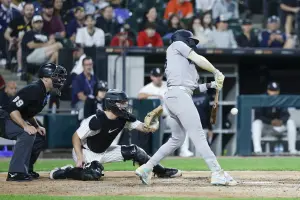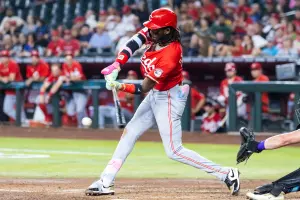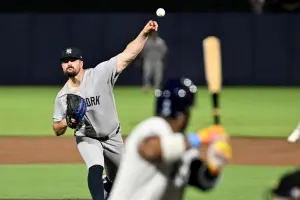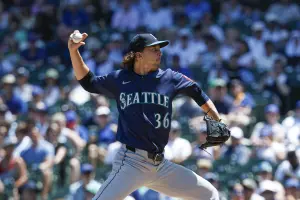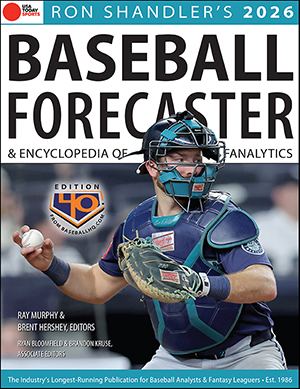
(*) FACTS/FLUKES: Pence, Wieters, Forsythe, Samardzija, W. Davis
Pence slowing down, but still valuable ... After topping 640 plate appearances in seven consecutive seasons, Hunter Pence (OF, SF) has been slowed down by injuries in each of the past two seasons. How are the skills holding up?
Year AB HR/SB BA xBA ct% G/L/F h% HctX PX xPX hr/f Spd SBO ==== === ===== ==== ==== === ======== == ==== === === ==== === === 2012 617 24/5 .253 .254 76 51/17/32 29 101 110 96 16% 118 4% 2013 629 27/22 .283 .280 82 47/17/36 31 116 128 112 15% 118 15% 2014 650 20/13 .277 .264 80 52/14/34 32 97 112 88 11% 164 11% 2015 207 9/4 .275 .279 77 54/17/29 32 119 135 118 20% 90 10% 2016 395 13/1 .289 .254 76 55/17/28 35 93 104 79 15% 106 2%
In addition to the health woes, Pence is showing some small signs of decline:
- He's been striking out more lately, but his batting average was aided by a high hit rate in 2016. Chances are, he'll hit for a lower average in 2017, though the drop-off shouldn't be severe.
- His fly ball rate, HctX, and xPX all reached career lows in 2016. He's shown that he can maintain an inflated home run per fly ball rate, but even if he stays healthy, he's no lock for 20 homers anymore.
- A lingering hamstring issue probably played a role in his inactivity on the base paths. He'll probably bounce back with a few more steals in 2017, but his age and recent Spd scores suggest betting against a return to double digits.
Long known for his durability and five category contributions, Pence has been a disappointment each of the past two seasons, when his combined at-bat total was fewer than any single year since 2009. At the same time, he's been a non-factor in the stolen base department, and his power metrics have shown some blemishes. Both his ceiling and floor look considerably lower these days, but Pence should still contribute with some decent pop and a solid average, making him a decent gamble on his modest price tag (NFBC ADP of 212).
There’s more where this came from to help you win your fantasy league in 2017. Take the title home with a subscription to BaseballHQ.com.
Power remains consistent for Wieters ... After missing much of the previous two seasons due to an elbow injury that required Tommy John surgery, Matt Wieters (C, WAS) stayed pretty healthy in 2016, finishing with 17 home runs. Now slated to serve as the starting backstop in Washington, is there still another level he can get to?
Year AB HR BA xBA bb% ct% G/L/F h% HctX PX xPX hr/f ==== === == ==== ==== === === ======== == ==== === === ==== 2012 526 23 .249 .265 10 79 44/20/35 28 110 119 113 16% 2013 523 22 .235 .256 8 80 39/18/44 25 105 122 126 12% 2014 104 5 .308 .292 5 82 28/30/43 34 138 127 160 14% 2015 258 8 .267 .255 8 74 43/25/32 33 101 109 113 13% 2016 423 17 .243 .261 7 80 36/24/40 27 107 94 113 13%
Wieters can still help out in the power department:
- He bumped his fly ball rate back up, and his HctX and xPX were in line with his career norms (outside of the small sample 2014 season). However, his PX fell to it's lowest level since 2010.
- His home run per fly ball rate has been consistently strong throughout most of his career. The change in home parks shouldn't affect him too much, as he's leaving a park that increases RHB homers by six percent to one that is neutral.
- After striking out more than usual in 2015, Wieters rebounded in 2016, only to be hurt by a low hit rate, including a 23 percent mark in the second half. He has some bounce back potential, and at the very least, puts the ball in play enough so that he won't be a huge BA drag.
Since returning from his serious elbow injury in the summer of 2015, Wieters has basically picked up where he left off, providing plus power at the scarce catcher position. With a contact rate that typically falls around 80 percent, he's not a BA killer, and his .268 first half average in 2016 shows what he's capable of when the hits fall in. Wieters looks like a good bet to at least repeat, which along with the .275, 25 HR upside projection in the Baseball Forecaster, makes him an attractive mid-tier option at catcher.
Forsythe could be a bargain ... Logan Forsythe (2B, LA) proved that his breakout 2015 season wasn't a fluke, as he belted 20 home runs, and maintained his grasp on a full-time role. Acquired by the Dodgers over the winter, he's in line to start at second base, and potentially lead off on a regular basis. Does he make for an attractive draft-day target?
Year AB HR/SB BA/xBA OPSvR bb% ct% G/L/F h% HctX PX xPX hr/f Spd ==== === ===== ========= ===== === === ======== == ==== === === ==== === 2012* 373 7/10 .263/.249 .603 9 79 36/29/35 32 112 77 107 7% 155 2013* 245 7/6 .221/.254 .593 9 74 42/28/29 27 100 94 105 13% 108 2014 301 6/2 .223/.224 .536 8 76 41/19/40 27 83 80 100 6% 104 2015 540 17/9 .281/.255 .728 9 79 40/20/41 33 108 109 105 10% 107 2016 511 20/6 .264/.259 .778 8 75 42/23/35 32 110 110 115 15% 122 *Includes MLEs
Forsythe's boasts a solid skill base:
- He has shown slightly above average power in each of the past two seasons, and is moving from a home park that reduces RHB home runs by 15 percent to one that is neutral. That being said, his track record suggests that his home run per fly ball rate will probably drop a bit, so if he doesn't bump his fly ball rate back up, he may not quite reach 20 homers again.
- His batting average predictably slipped from his career high .281 mark in 2015. He consistently strikes out in more than 20 percent of his at-bats, and his xBA typically settles into the .250-.260 range, which provides a reasonable baseline for him.
- He possesses above average speed, but it doesn't typically translate to many stolen bases. Given that he had a 50 percent success rate in 2016, and is moving to a team that finished 27th in the majors in steals a season ago, owners shouldn't expect much from Forsythe on the base paths.
- An inability to handle right-handed pitching used to cut into his playing time, but he's shown dramatic improvement against them during the past two seasons. Chase Utley is lurking should Forsythe fall back into his old ways, but his recent success against righties suggests he's well-suited for a full-time job.
Forsythe has evolved offensively in recent years, as he's now displaying much more power, while also finding success against right-handed pitchers. He's proven that he's capable of holding down a regular job, and could be in line to spend a second straight year in the leadoff spot, though the Dodgers do have a couple sensible options from the left side of the plate who could push him down some against right-handed starters. Bottom line, Forsythe makes for a rock solid middle infield option at a very reasonable price (NFBC ADP of 223).
Where is Samardzija's ERA headed next? ... After suffering through a rough season in 2015, Jeff Samardzija (RHP, SF) lowered his ERA by more than a run in his first year in San Francisco. What can we expect heading into 2017?
Year IP ERA xERA Ctl Dom Cmd FpK SwK G/L/F H% S% hr/f BPV ==== === ==== ==== === === === === === ======== == == ==== === 2012 175 3.81 3.45 2.9 9.3 3.2 60% 13% 45/22/33 30 72 13% 112 2013 214 4.34 3.49 3.3 9.0 2.7 60% 11% 48/20/31 32 70 13% 100 2014 220 2.99 3.05 1.8 8.3 4.7 65% 12% 50/19/31 29 75 11% 129 2015 214 4.96 4.25 2.1 6.9 3.3 62% 10% 39/21/40 31 64 11% 85 2016 203 3.81 4.00 2.4 7.4 3.1 63% 10% 46/20/34 29 72 12% 93
Samardzija remains a workhorse, but the skills have slipped a bit:
- He's missed fewer bats the past two seasons, and looks to have settled in as a decent, but not great, source of strikeouts.
- Walks were a problem for him early in his career, but he's made significant improvements. Don't expect a return to his 2014 level, but his above average FpK indicates his Ctl should remain pretty low.
- At times, he's had some trouble keeping the ball in the park, but he's in a home park that suppresses home runs from both sides of the plate. In fact, just seven of the 24 homers he allowed in 2016 were at AT&T Park.
Samardzija's ERA column has been a roller coaster over the last four seasons, but through that time, he's been a horse, topping 200 innings each year. He's lost some ability to miss bats, but doesn't walk many batters, and got his ground ball rate back up in 2016. Samardzija doesn't offer the type of upside of several other similar priced pitchers (NFBC ADP of 199), but there's value in his ability to consistently take the mound every fifth day, and his home park limits the downside.
Health is the question for Davis ... Wade Davis (RHP, CHC) was in the midst of another fine season when he hit the DL with an elbow injury in early July. He made it back for just five appearances before he was out again, but eased some concern with a September return, where he was unscored upon in his final seven appearances. Now taking the ninth inning reigns in Chicago, can he be an elite closer?
Year IP Sv ERA xERA Ctl Dom Cmd FpK SwK G/L/F H% S% hr/f BPV ==== == == ==== ==== === ==== === === === ======== == == ==== === 2014 72 3 1.00 2.08 2.9 13.6 4.7 61% 15% 48/22/30 29 87 0% 194 2015 67 17 0.94 3.04 2.7 10.4 3.9 61% 12% 38/21/41 21 92 5% 131 2016 43 27 1.87 3.47 3.3 9.8 2.9 53% 13% 49/18/33 30 82 0% 113
Davis is good, but not quite as dominant as his ERA would suggest:
- He missed a ridiculous amount of bats in 2014, his first full season as a reliever. He hasn't generated quite as many whiffs the past two seasons, but it appears he can be counted on for at least a strikeout per inning.
- His FpK was obviously poor in 2016, but it's worth noting that it was 59 percent in the first half, before slipping to 40 percent in 15 second half appearances. Perhaps with an off-season to recover, Davis will be able to attack the zone early in the count.
- He does a pretty nice job of keeping the ball down, though not enough to support his feat of not allowing a home run in two of the past three seasons. He's due for a correction, and moves to a park that is a little more homer-friendly, but the long ball still shouldn't be much of an issue for him.
Davis has had a great deal of success since making the transition to full-time reliever, posting a 1.18 ERA over the past three seasons. His xERA history shows that he's been pretty fortunate, and has also been trending in the wrong direction, but an elbow issue probably contributed to the lesser skills in 2016. His Dom is unlikely to return to his 2014 level, but Davis still possesses swing and miss stuff, and finishing strong down the stretch is a positive sign for his health. With an elite defense behind him, Davis is a good bet to outperform his skills again, and if health cooperates, should end up a top-tier closer.


